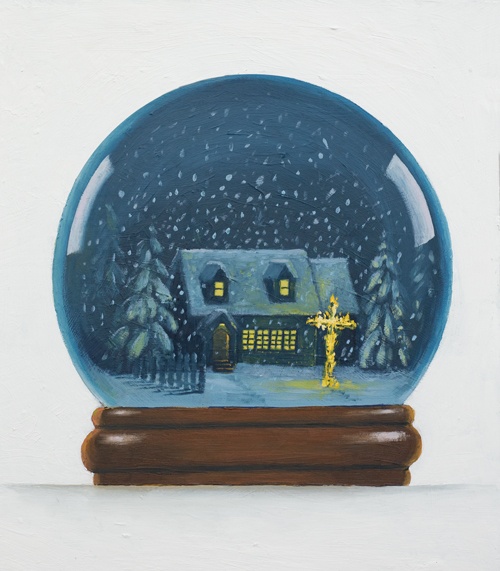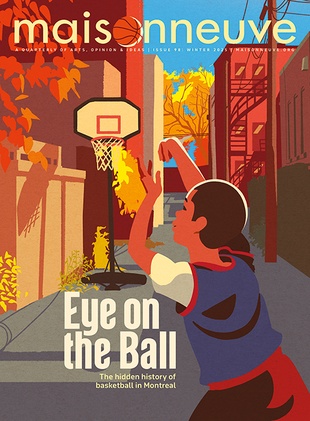 Illustration by Paul Gagner.
Illustration by Paul Gagner.
Ku Klux Canada
Robyn Maynard on our nation’s forgotten and far-from-over history of populist anti-Black violence.
On February 28, 1930, seventy-five men in white robes and hoods staged a march through Oakville, Ontario. According to archival research completed by historian Constance Backhouse, after planting and burning a cross in the middle of town, the men drove to the home of an interracial couple—Ira Johnson, a Black man, and Isabel Jones, a white woman.
They brought Jones to the home of her white relatives before forcing a petrified Johnson into a car, retrieving his elderly aunt and uncle, returning to his house, and trapping the family inside. The Klansmen surrounded the house, placed a large cross on a post in the front yard, and set the cross on fire. A Black neighbour eventually located the police and informed them of the situation.
When the police chief, Chief Kerr, arrived and investigated the surrounding area, he discovered a caravan of cars filled with men in white robes. He identified which of the men had kidnapped and besieged Ira Johnson and his relatives. He recognized the attackers; he knew some of them personally.
Chief Kerr made no arrests, warnings or condemnation of any kind. Instead, he shook the perpetrators’ hands.
The mayor of Oakville was subsequently quoted in the Toronto Daily Star; the Klan had acted “quite properly,” he said, since “there was a strong feeling against the marriage which the young girl and the Negro had planned.” Other newspaper outlets reported a generally positive response among the white community of Oakville and nearby towns.
Despite a carefully curated national narrative of tolerance—spanning, usually, from the Underground Railroad through the Multiculturalism Act—the characterization of Canada as historically welcoming and benevolent is illusory, and disguises a less palatable truth: state policies of racist exclusion, coinciding with upswings of populist violence, are a mainstay of Canadian history.
While campaigning in 2016, Donald Trump told the media that Mexican immigrants were rapists in order to gain popular support and stir xenophobic hostility towards migrants. Many Canadians reacted to his words with shock and horror, but this rhetorical strategy is not foreign to Canada’s history. In 1868, Canada’s first Prime Minister, Sir John A. Macdonald, argued that Black men were “very prone to felonious assaults on white women” as a justification for keeping rape a capital offense.
Similarly, in Edmonton, from 1910 to 1911, newspaper editors, government officials and an imperialist women’s group petitioned the federal government to keep out as many Black migrants as possible, contending, among other things, that Blacks were a sexual threat who would endanger white women. A total of 3,400 people—representing almost 14 percent of Edmonton’s total population—signed the petition. C.E. Simmons, a Conservative politician from Lethbridge, told a large Edmonton audience, “We want no dark spots in Alberta.” Widespread (and unsubstantiated) fears of “Black crime” soon spread the call to other prairie cities.
Due to concerns about public image, the government chose not to formally ban Black migration, relying instead on informal policies. That same year, as uncovered by the research of historian R. Bruce Shepard, Canada’s Department of the Interior (the department in charge of immigration until 1917) paid Black doctors to go to Northwestern American states like Oklahoma and Kansas to tell Black would-be migrants that they would likely not survive Canada’s climate. One such doctor was instructed to tell African-American men that their wives and daughters would be stripped naked and examined by boards of men at the border—invoking the still-recent trauma of slave auctions. In another unofficial measure, documented by sociologist Agnes Calliste, Canadian immigration agents told steamship companies that they were not allowed to sell tickets to Black people hailing from the Caribbean. Those who disobeyed would have to assume financial responsibility for the cost of refusal at the border, as well as for any resulting detention and deportation for up to three years afterwards. Though informal, these policies almost stopped Black migration entirely for many years following.
Taking comfort in our supposed superiority over Americans isn’t new either. In a 2003 paper for the Canadian Society of Church History, historian Kristin McLaren points out that in the mid-nineteenth century, British settlers celebrated their abolition of slavery as a moral victory over the United States, an exemplar of racial equality over barbarity; meanwhile, informal “sundown” laws restricted Black people’s ability to be in some Ontario towns after dark well into the twentieth century. In 1850, Ontario Member of Parliament Malcolm Cameron told Black stockholders of the Elgin Association that he “ever advocated the perfect equality of all mankind, and the right of all to every civil and religious privilege without regard to creed or colour”—only one year after he had successfully championed a bill in the legislature which would force Black students to attend segregated schools in Ontario West. The white Canadian desire not to seem racist cannot be conflated with actual opposition to white supremacy.
The politics of white hate, then and now, regularly extend beyond political measures and spill into violence. Historical research by Sarah-Jane Mathieu, Constance Backhouse and Howard Palmer all expose the significant role of white supremacist activity in the early- to mid-twentieth century. Far from fringe, open white supremacist politics were then a feature of Canadian life. Just outside St. Catharines, ten years prior to Oakville’s cross-burning, several newspapers reported that a white mob had set the town hall on fire and intended to lynch a Black ex-soldier who was accused of murdering a child. In June 1927, an estimated ten thousand people gathered in Moose Jaw as Klansmen burned a sixty-foot cross and proclaimed, “one flag, one language, one race, one religion, race purity and moral rectitude”—the Ku Klux Klan was even allowed to financially support the wing of a Moose Jaw hospital, which boasted a plaque celebrating “Law and Order, Separation of Church and State, Freedom of Speech and Press, [and] White Supremacy.” By the summer of 1928, the Saskatchewan Klan membership had reached 20,000, in a province that Statistics Canada estimates had fewer than a million people in 1931; this was a higher proportion than in Montana, bordering Saskatchewan to the south, which had about 5,100 members in 1924—according to Boys in Butte by Christine K. Erickson—for its population of about 540,000. The Ku Klux Klan was credited with helping elect Saskatchewan’s Conservative government in June 1929.
When this past is acknowledged, which is all too rare, it’s represented as a bygone era, a shameful history that has since been surpassed. But despite hard-won advancements in human rights legislation, contemporary Canadian life is replete with persistent racial violence that can only be called white hate.
In 1995, video surfaced, taken two years earlier in Somalia, of a member of Canada’s Airborne Regiment tying a Black soldier to a tree, smearing him in feces—the words “I love the KKK” written on his back—and forcing him to crawl on his hands and knees. Cross burnings and noose hangings in Nova Scotia have made headlines as recently as 2011. Just this past January, six Black and Brown Muslim men in a Quebec City mosque—Khaled Belkacemi, Azzedine Soufiane, Aboubaker Thabti, Abdelkrim Hassane, Mamadou Tanou Barry and Ibrahima Barry—were slaughtered by a white gunman, thought to be a fan of Trump.
These incidents can’t be dismissed as the acts of a few errant individuals. While civilians that inflict racist violence upon people or communities are often (but not always) punished, Canadian law enforcement officers—representatives of the Canadian state—have played their own integral role in inflicting racial terror against Black communities in recent decades. From the high-profile police killings of Michael Wade Lawson and Anthony Griffin in the late 1980s to the more recent violent deaths of Andrew Loku in 2015 and Jean-Pierre Bony and Abdirahman Abdi in 2016, the intimidation of Black communities is propped up by institutions that are tasked, supposedly, with protecting the public good. Moreover, this documented pattern of institutionalized violence has gone largely unpunished.
With the ascent of Trump, a politics of white rage has been granted renewed legitimacy, power and scope. It is increasingly clear that what many imagined to be an embarrassing historical relic, is, in fact, the lived experience of the present, threatening to define our future. If, as activist-scholar Angela Y. Davis asserts, the challenge of surviving the coming years will be to “extricate ourselves from the backward pull of history,” we can’t deny or repress the historical fact of white rage as it has shaped and continues to shape this country. Given the rising popularity of white supremacist politics across Canada, the United States and Western Europe, challenging the power of white hate will require more than the outward disavowal of racism. It will rely on society’s ability to learn from, and break with, its history of racial dominance and violence.





